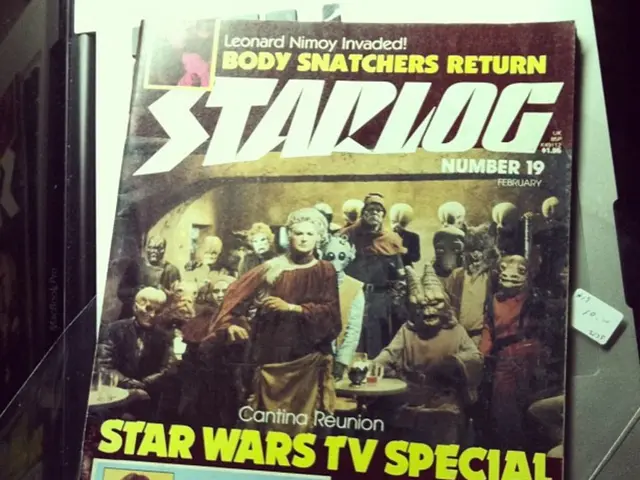The enigmatic demeanor of youth: Exploring the enigma of the "Gen Z Icon"
In the digital age, a new phrase has emerged on social media platforms, dubbed the "Gen Z Stare." This term refers to a blank, vacant, or expressionless look that many members of Generation Z (roughly ages 13 to 28 in 2025) are said to give in response to questions or casual greetings in various contexts, such as classrooms, workplaces, restaurants, and customer service interactions[1][5].
However, it is important to note that the "Gen Z Stare" is not a formally recognised clinical or neurological diagnosis. Instead, psychologists and researchers interpret it as a cultural and generational communication style that may stem from several influences.
One theory suggests that the neurological development of Gen Zers, who were in critical brain development phases during the COVID-19 pandemic, might influence their social reactions and engagement[2]. Another hypothesis points to the impact of cultural shifts and social media, where growing up highly exposed to curated social media imagery can lead to emotional fatigue or "affective flattening," causing a blank or unimpressed expression to signal skepticism or rejection of overly polished online personas[3][4].
Moreover, extended online exposure and self-monitoring can result in a rehearsed neutral "rest-neutral" facial expression to avoid awkward freeze-frames in online or real-life interactions[4]. Limited social interactions during the pandemic and possible trauma-related freeze responses may also contribute to reduced spontaneous social engagement reflected in the stare[5].
Experts caution that the "Gen Z Stare" is a folk term or modern shorthand for a communication quirk, not a medical or psychological syndrome[4]. It is part of a recurring pattern where each generation receives stereotyped judgments from older generations about perceived expressionlessness or disengagement[4].
Not all young people exhibit the Gen Z Stare or mimic it on social media, as sociologist Rohmann points out[6]. Examples of Gen Z celebrities who do not seem to exhibit the Gen Z Stare include Jenna Ortega (22, "Wednesday") and Lily-Rose Depp (26, "Nosferatu").
In conclusion, while the "Gen Z Stare" is widely recognised socially and culturally with plausible psychological and developmental explanations, no rigorous scientific studies yet define it as a clinical phenomenon or prove its existence as a distinct neural or psychological condition[2][4]. It is best understood as a generational style of social expression shaped by cultural, technological, and developmental contexts.
[1] [Sociologist Rohmann suggests that a friendly conversation can clarify any misunderstandings, even if it involves a fixed gaze, not just from Gen Z.] [2] [Generations span about 15 years, making it unlikely for the facial expression to change so quickly and dramatically between Gen Z and the Baby Boomers.] [3] [On social media, English-speaking users claim the Gen Z Stare typically appears in customer interactions, such as when ordering coffee at a café or restaurant.] [4] [The Gen Z Stare is not scientifically proven, according to experts.] [5] [In these videos, young people are portrayed as having rude or absurd customers, leaving them with only a blank stare.] [6] [Rüdiger Maas, a generations researcher, warns against immediately perceiving every peculiarity discovered on social media as a Gen Z phenomenon.] [7] [Claudia Paganini, a media ethicist, finds a certain caution or reserve in facial expression quite understandable due to this risk.] [8] [Some users attribute the Gen Z Stare to a lack of social skills or disinterest.] [9] [Social scientist Gabriele Rohmann views the Gen Z Stare as a "clichéd and prejudiced phenomenon."] [10] [In today's world, anyone's facial expression can be photographed in public and potentially go viral.] [11] [One video on TikTok humorously portrays a rude customer demanding a latte with cow's milk despite being lactose intolerant, to which the server responds with a disbelieving, blank stare.] [12] [The theory that people who grow up heavily using smartphones and new media show less facial expression in conversation is considered quite daring by Paganini.] [13] [Rohmann states that there is great diversity within the age group, and not all young people exhibit the Gen Z Stare or mimic it on social media.]
Read also:
- Critique on Gender Issues: Deniz Yücel draws a parallel between Minister of Culture and former East Germany's chief ideologist Kurt Hager
- "Primal instincts at play: Subnautica 2 designer notes our affinity for weapon-making stems from a fundamental desire for protection and sustenance"
- Dragon Age series might find a promising future with remasters, according to ex-BioWare producer Mark Darrah, but it seems unlikely that EA and BioWare possess the capability for such undertakings at present.
- Chinese Ambassador issues stern message to India regarding Trump's tariffs in midst of escalating trade feuds








